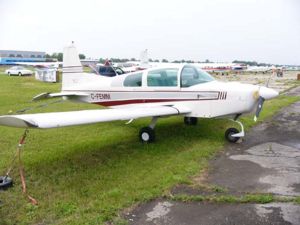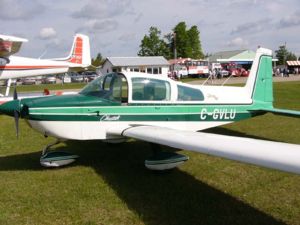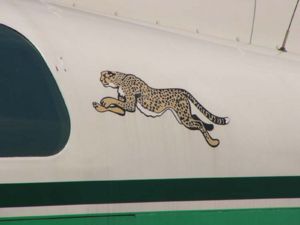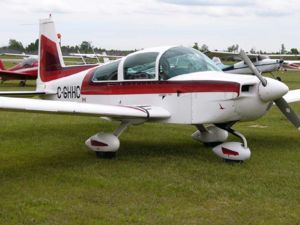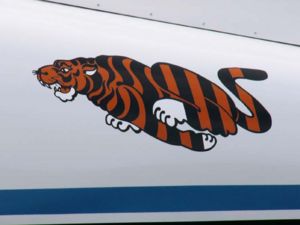PlaneSpottingWorld welcomes all new members! Please gives your ideas at the Terminal.
Grumman American AA-5
| AA-5/AG-5 Aircraft Series | |
|---|---|
| Grumman American AA-5B Tiger | |
| Type | Personal Aircraft |
| Manufacturer | American Aviation, Grumman American, Gulfstream American, American General Aviation Corporation, Tiger Aircraft |
| Designed by | American Aviation |
| Introduced | 1971 |
| Produced | 1971-2006 |
| Number built | 3282 |
The Grumman American AA-5 series is a family of all-metal, 4-seat, light aircraft. The line includes the original American Aviation AA-5 Traveler, the Grumman American AA-5 Traveler, AA-5A Cheetah, and AA-5B Tiger, the Gulfstream American AA-5A Cheetah, and AA-5B Tiger, the American General AG-5B Tiger, and the Tiger Aircraft AG-5B Tiger.
Contents
Development
Following American Aviation's success with the AA-1 Yankee Clipper two place light aircraft in 1969, the company decided to produce a four-seat aircraft. They started with a new "clean-sheet" design that was designated the American Aviation AA-2 Patriot. The AA-2 design did not meet its performance goals during test-flying and only one was ever built.
Without the needed four-seat design for the market, the company simply enlarged the external and cabin dimensions of the AA-1 Yankee to create the four-seater. This decision capitalized on the marketplace identification of the Yankee and its derivative the AA-1A Trainer and also resulted in 2/3 parts commonality between the designs, saving development time and production costs.
AA-5 Traveler
The new four-place aircraft, named the American Aviation AA-5 Traveler, was powered by a Lycoming O-320-E2G engine of 150 hp. It would carry four people at 121 kts cruise speed and was certified under FAR Part 23.
Production of the Traveler had just started in 1971 when American Aviation was sold to Grumman and became the Grumman American division. Grumman continued production of the Traveler. 834 Travelers had been produced when production of this model ceased in 1975.
A redesign of the AA-5 was undertaken in 1974 and as a result the 1975 model Traveler featured an aerodynamic clean-up of the engine cowling and main gear fairings. The tail section remained unchanged. As a result of these changes the 1975 Traveler had a cruise speed of 127 kts. The Traveler was superseded in production the following year by the further refined AA-5A Cheetah.
AA-5A Cheetah
Grumman's engineers felt the AA-5 design had more speed potential than the original Traveler, even with its 1975 improvements, and so embarked on an aerodynamic clean-up and re-design. Changes were made to the engine cowling and baffling to reduce cooling drag, the exhaust system was redesigned, the main gear fairings were further improved, the ventral fin was deleted and the horizontal tail was enlarged to allow a larger center of gravity range. Fuel was increased from the Traveler's 37 US gallons to 52 gallons, increasing range greatly.
The new variant was named the AA-5A Cheetah and was introduced as a 1976 model in late 1975. In keeping with its namesake it was 6 knots (7 mph) faster than the Traveler on the same 150 hp Lycoming O-320-E2G powerplant. Because the Cheetah looked very much like the Traveler externally, Grumman’s marketing department created a "leaping cheetah" emblem to differentiate it from the earlier AA-5.
Grumman sold its light aircraft division to Gulfstream Aerospace in 1978 and the division was renamed Gulfstream American. Gulfstream continued production of the AA-5A until 1979. A total of 900 Cheetahs were produced.
AA-5B Tiger
The final variant of the AA-5 line is the AA-5B Tiger. The Tiger was designed by Grumman engineers and was first produced in late 1974 as the 1975 model.
The Tiger was the outcome of the same redesign work on the AA-5 Traveler that resulted in the 150 hp Cheetah and it was originally little more than the same aircraft with a Lycoming O-360-A4K 180 hp engine, resulting in a 139 knot cruise speed. Gross weight was increased from the AA-5/AA-5A's 2200 lb to 2400 lb on the Tiger. Externally the Tiger looked much like the AA-5 Traveler and AA-5A Cheetah so once again Grumman’s marketing department came up with a distinctive decal package to differentiate the design – this time a "galloping tiger".
While the earlier AA-1s and AA-5s did not change much from year to year the AA-5B Tiger underwent almost continual improvement. As with the AA-5A, the AA-5B was continued in production by Gulfstream when they purchased Grumman's American division. Gulfstream ceased production of all piston-engined aircraft in 1979 and the highly successful Tiger design went out of production after 1323 aircraft had been delivered.
AG-5B Tiger
For eleven years the design was not produced and then in the late 1980s a new company was formed to produce the Tiger. American General Aviation Corporation carried out further design improvements including introducing a new split nose bowl that could be removed without removing the propeller, a new instrument panel and improved exterior lighting, a new fuel indication system, a 28 volt electrical system replacing the older 14 volt system, a new style throttle quadrant and improvements to the heat and ventilation systems. Aerodynamic improvements raised the optimal altitude cruise speed from 139 knots true airspeed to 143 knots TAS. The redesigned aircraft was put into production under an amended type certificate as the American General AG-5B Tiger. The new company had considered producing AA-1s and AA-5A Cheetahs, but those plans were never fulfilled before it closed its doors in 1993. American General only produced Tigers for model years 1990-93 and delivered just 181 aircraft in that time.
The design has a strong following amongst pilots and aircraft owners and so in 1999 a new company was formed to put the Tiger back into production. Tiger Aircraft LLC started production of the AG-5B Tiger in 2001 at their plant in Martinsburg, West Virginia. Tiger Aircraft did not produce any other models of the AA-1 or AA-5 family, although they owned the type certificates for the complete line of aircraft. Between 2001 and 2006 Tiger Aircraft produced 51 AG-5Bs. By the middle of 2006 Tiger Aircraft was experiencing financial problems and production of AG-5Bs had been halted and production workers laid off. [1] [2]. On November 30th 2006 it was announced that the company's buildings were for sale. [3]
AA-5 & AG-5 Production
All told a totalof 3282 AA-5s and AG-5s were produced by all five manufacturers between 1971 and the end of 2005.
Construction
All models of the AA-5 have four seats under a sliding canopy, which can be partly opened in flight for ventilation. Entry for all four occupants is from the wing root over the canopy sill. Compared to competitive aircraft of the same era the AA-5s are noted for their exceptionally light and pleasant handling characteristics as well as high cruising speed for the installed power.
As derivatives of the original AA-1 Yankee, the AA-5 series share the same unique bonded aluminum honeycomb wing and fuselage that eliminates the need for rivets without sacrificing strength. The main landing gear is fibreglass with a sprung steel nose gear tube. There is no nose wheel steering as the nose wheel is free-castering through 180 degrees. Steering is by main wheel differential braking operated by depressing the toes of the rudder pedals.
Aircraft Type Club
The AA-5 family of aircraft along with the other American Aviation, Grumman American and Gulfstream American single and twin-engined aircraft are supported by an active aircraft type club, The American Yankee Association and the Grumman Gang on-line community.
Specifications (2005 model Tiger Aircraft AG-5B Tiger)
General characteristics
- Crew: 1 pilot
- Capacity: 3 passengers
- Length: 22 ft 0 in (6.7 m)
- Wingspan: 31 ft 6 in (9.6 m)
- Height: 8 ft 0 in (2.4 m)
- Wing area: 140 ft² (13 m²)
- Empty: 1,500 lb (680 kg)
- Loaded: 2,400 lb (1090 kg)
- Maximum takeoff: 2,400 lb (1090 kg)
- Powerplant: 1× Lycoming O-360-A4K, 180 hp (134 kW)
Performance
- Maximum speed: 143 kt (265 km/h)
- Range: 789 miles (1,270 km)
- Service ceiling: 13,800 ft (4,200 m)
- Rate of climb: 850 ft/min (259 m/min)
- Wing loading: 17.1 lb/ft² (83 kg/m²)
- Power/mass: 0.08 hp/lb (0.12 kW/kg)
External links
References
- Aviation Consumer Used Airplane Guide 1989 Article - Gulfstream Tiger/Cheetah AA-5B/A
- Grumman Gang AA-5 Specifications and production numbers
- AG-5B Production update
- Article about the sale of Tiger Aircraft's buildings accessed 30 November 2006
Related content
Related development
Comparable aircraft
Designation sequence
AA-1 - AA-2 - AA-5 -
GA-7
Lists relating to aviation | |
|---|---|
| General | Timeline of aviation · Aircraft · Aircraft manufacturers · Aircraft engines · Aircraft engine manufacturers · Airports · Airlines |
| Military | Air forces · Aircraft weapons · Missiles · Unmanned aerial vehicles (UAVs) · Experimental aircraft |
| Notable incidents and accidents | Military aviation · Airliners · General aviation · Famous aviation-related deaths |
| Records | Flight airspeed record · Flight distance record · Flight altitude record · Flight endurance record · Most produced aircraft |
